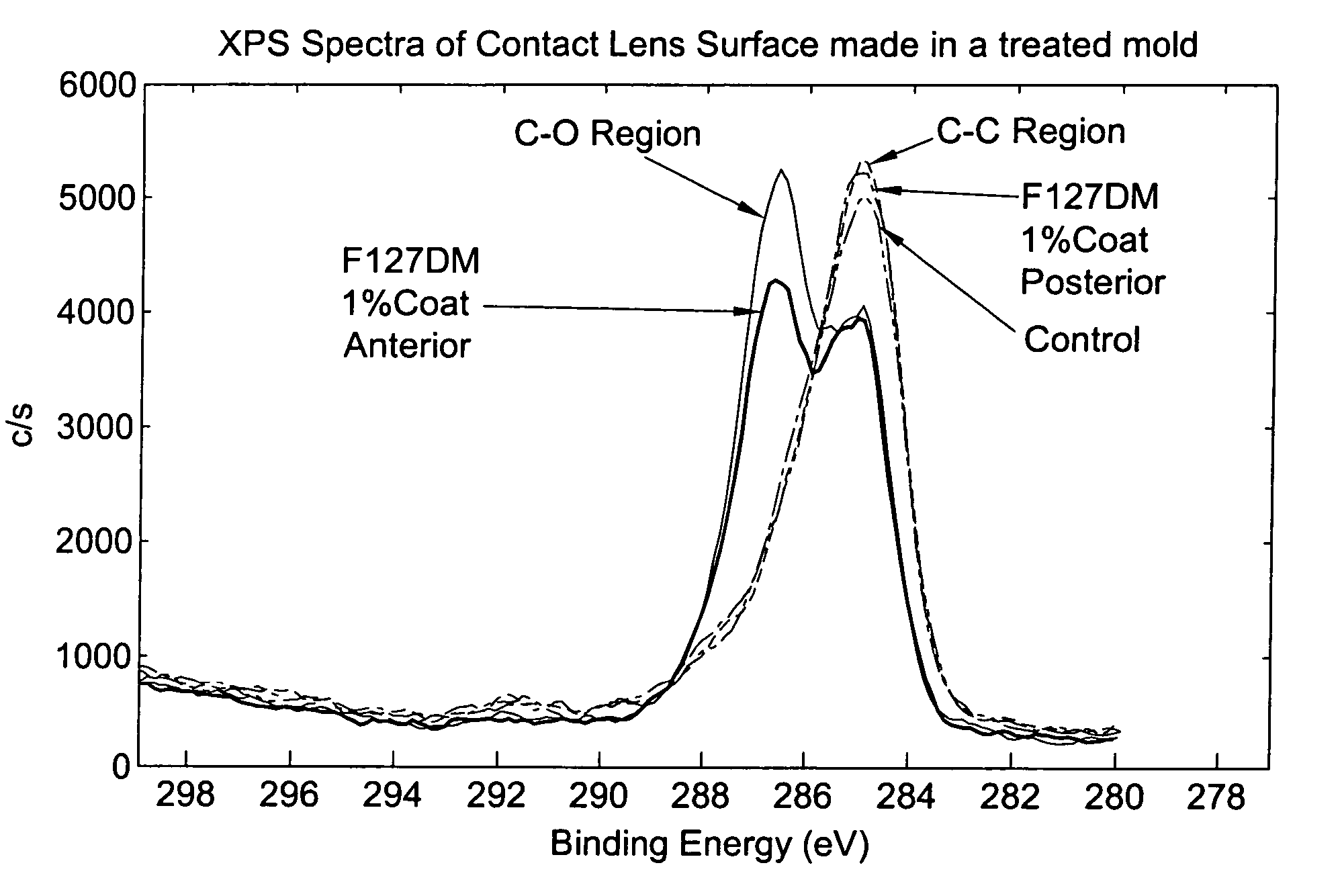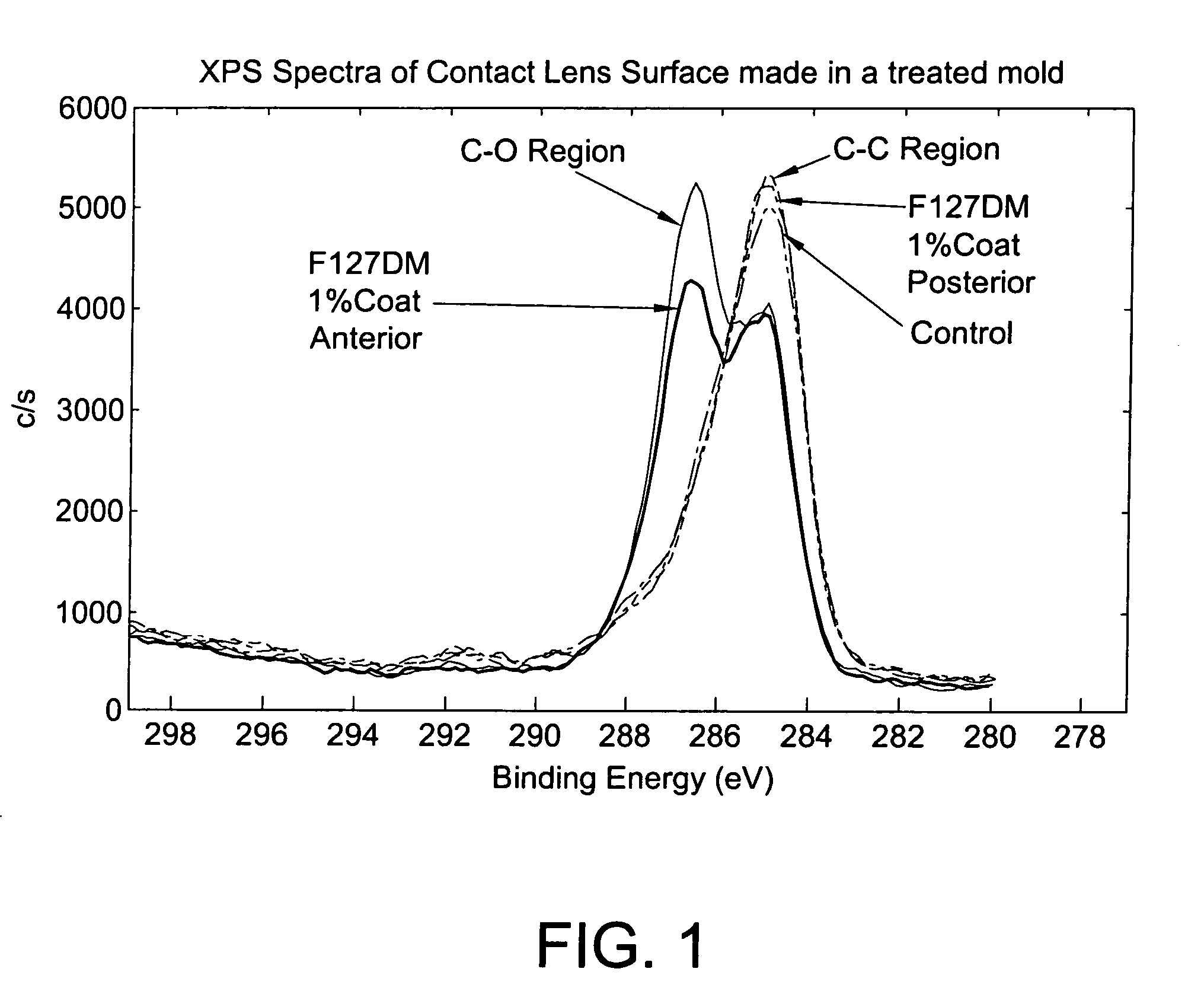Method for coating lens material
a lens material and coating technology, applied in the field of coating lens materials, can solve the problems of eye discomfort or even inflammation, surface of the lens can affect the susceptibility of the lens to deposition, and achieve the effects of improving lipid and microbial behavior, reducing the attachment of lens epithelial cells, and improving wettability
- Summary
- Abstract
- Description
- Claims
- Application Information
AI Technical Summary
Benefits of technology
Problems solved by technology
Method used
Image
Examples
example 1
Synthesis of End-terminal Functionalized Copolymers
[0086] 6.00 g of PLURONIC F127 was placed in a round bottom flask and dried thoroughly via azeotropic distillation of toluene (100 ml). The round bottom flask was then fitted with a reflux condenser and the reaction was blanketed with nitrogen gas. Anhydrous tetrahydrofuran (THF) (60 ml) was added to the flask and the reaction was chilled to 5° C. with 15 equivalents (based upon the hydroxyl endgroups) of triethylamine (TEA) was added (2.0 ml). 1.4 ml of methacryoyl chloride (15 equivalents) was dropped into the reaction mixture through an addition funnel and the reaction mixture was allowed to warm to room temperature and then stirred overnight. The reaction mixture was then heated to 65° C. for 3 hours. Precipitated salt (TEA-HCl)was filtered from the reaction mixture and the filtrate was concentrated to a volume of around 355 mL and precipitated into cold heptane. Two further reprecipitations were performed to reduce the amount ...
example 2
Synthesis of Surfactant Epoxides
[0087] 10.00 gms of PLURONIC F38 (2.13E-03 mol) are placed in a round bottom flask and dried thoroughly via azeotropic distillation of toluene and then dissolved in 100 mL of THF. 10 equivalents of solid NaH were added into the flask (0.51 gm; 2.13E-02 mol). Next, 1.67 mL of epichlorohydrin (2.1 3E-03 mol) was added to the reaction mixture and mixed well and the reaction mixture was heated to reflux for 24 hours. The reaction mixture was cooled and a scoop of magnesium sulfate and silica gel was added to remove any water. This was mixed well for 5 minutes and then filtered off the insolubles. The filtrate was concentrated to around 30 mL final volume and the product was precipitated into heptane and isolated by filtration. NMR confirmed the presence of epoxide groups on the termini of the polymer.
example 3
Purification of End-terminal Functionalized Copolymers
[0088] Different dimethacrylated PLURONICS and TETRONICS had to be purified by different techniques depending upon their ability to precipitate and their solubility in water. The purification technique used for each example is listed in Table 2 below:
TABLE 2#Mol. Wt.% EO / HLBFormMethodWater SolublePluronics1Pluronic F12712,60070 / 22solidPrec / Dialysis+2Pluronic P1056,50050 / 15pasteDialysis+3Pluronic P1235,75030 / 8 pasteDialysis+4Pluronic F384,70080 / 31solidPrec / Dialysis+5Pluronic L1013,80010 / 1 liquidWater / Centrifuge−6Pluronic L1214,40010 / 1 liquidWater / Centrifuge−Reverse Pluronics7Pluronic 10R51,95050 / 15liquidDialysis+8Pluronic 31R13,25010 / 1 liquidWater / Centrifuge−9Pluronic 25R43,60040 / 8 pasteDialysis+Tetronics10Tetronic 110715,00070 / 24solidPrec / Dialysis+11Tetronic 9046,70040 / 15pasteDialysis+12Tetronic 90825,00080 / 31solidPrec / Dialysis+13Tetronic 13016,80010 / 2 liquidWater / Centrifuge−Reverse Tetronics14Tetronic 150R18,00010 / 1 liquidWat...
PUM
| Property | Measurement | Unit |
|---|---|---|
| volume | aaaaa | aaaaa |
| volume | aaaaa | aaaaa |
| solubility | aaaaa | aaaaa |
Abstract
Description
Claims
Application Information
 Login to View More
Login to View More - R&D
- Intellectual Property
- Life Sciences
- Materials
- Tech Scout
- Unparalleled Data Quality
- Higher Quality Content
- 60% Fewer Hallucinations
Browse by: Latest US Patents, China's latest patents, Technical Efficacy Thesaurus, Application Domain, Technology Topic, Popular Technical Reports.
© 2025 PatSnap. All rights reserved.Legal|Privacy policy|Modern Slavery Act Transparency Statement|Sitemap|About US| Contact US: help@patsnap.com



